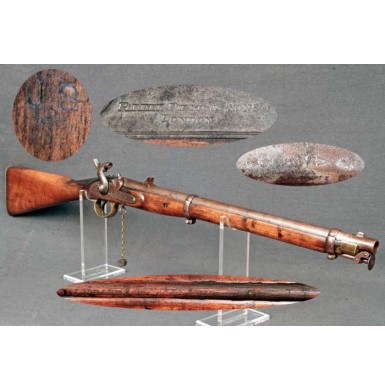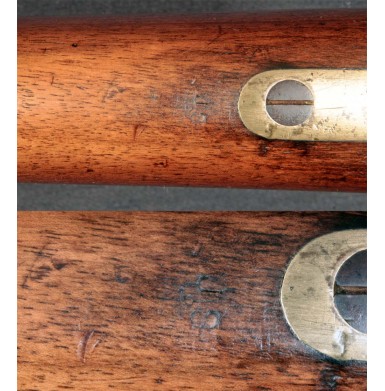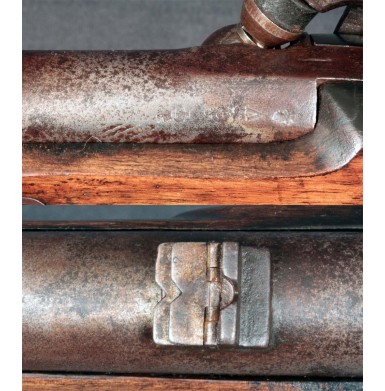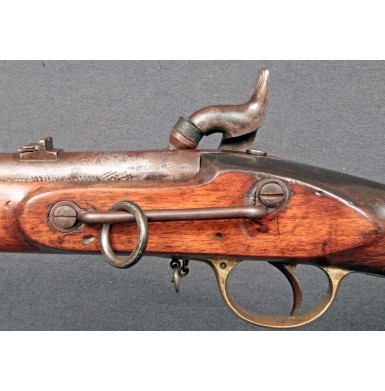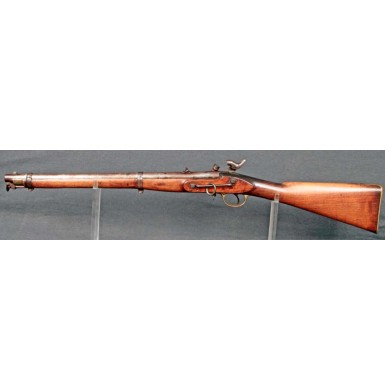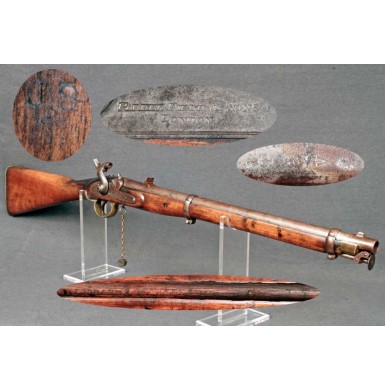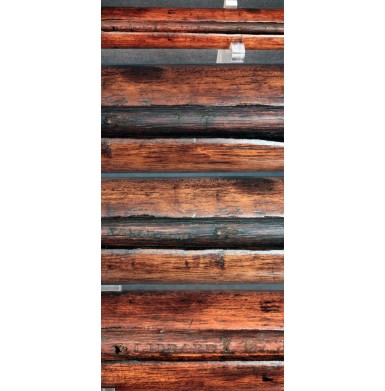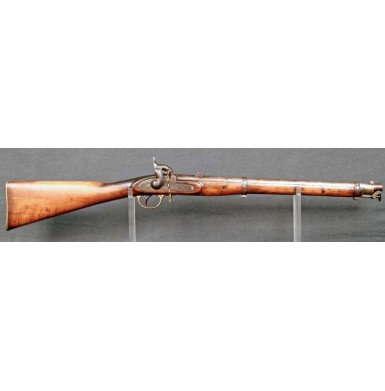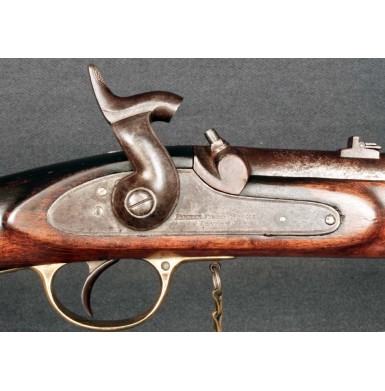Confederate Imported P-1856 Carbine with JS Anchor Marking
- Product Code: FLA-1904-SOLD
- Availability: Out Of Stock
-
$1.00
The P-1856 Cavalry Carbine is a rarely encountered Civil War era long arm, and even those carbines without Confederate import marks bring significant prices. The US Government only purchased about 250 of the carbines, and the Confederacy (by most researchers accounts) purchased about 10,000 of the guns. The majority of the Confederate purchased carbines appear to have been acquired and delivered during the last half of the war. In fact the Payne Ledger, which details the late war Confederate imports through Wilmington, NC notes, that some 4,700 English cavalry carbines were landed there between July of 1863 and November of 1864. These guns were likely marked with the (ANCHOR) / S mark on the comb of the stock, forward of the buttplate tang, and have lock dates of 1863 or 1864. At least some of the earlier guns, acquired before the fall of the 1862, would have likely had the JS / (ANCHOR) mark in the same location. Purchasing documents located in the McRae papers indicate that Caleb Huse purchased 120 Pattern 1856 cavalry carbines from S. Isaac, Campbell & Company on August 1, 1862. He paid 65 schillings each for these guns, and they were shipped to the Confederacy aboard the blockade-runner Gladiator. Huse purchased one additional case of 20 carbines from the same source on August 6, 1862 for the same price. These guns crossed the ocean in the hold of the blockade-runner Harriett Pinckney. These two orders only account for 140 of the carbines, and may be an indication of why the JS / (ANCHOR marked guns are so scarce. To date, the Confederate marked P-1856 carbines that are known have had locks marked TOWER (Birmingham contractor produced guns), BARNETT, or in extremely rare instances EP BOND. To my knowledge, and that of several credible authorities on the subject, no other extant lock markings were known on P-1856 cavalry carbines, in conjunction with Confederate viewers marks. That is until this P-1856 carbine, manufactured by Parker, Field & Sons, appeared on the market. The gun is marked with the early war Confederate viewer’s mark of a JS / (ANCHOR) on the comb of the stock, forward of the buttplate tang. I have to wonder if the single odd case of 20 carbines that was purchased by Huse on August 6 of 1862 was furnished by Parker, Field & Sons.
The firm of Parker Field & Sons had its origins in 1772, when William Parker went to work for himself as a gunmaker. Parker operated under that name until 1841, when the firm became Parker, Field & Sons. John Field was the son in law of William Parker, and he brought into the firm his sons John William Parker Field and William Shakespeare Field. From 1841-1849 they operated at William Parker’s previous location of 233 High Holborn in London. In 1850 they added a second address at 58 Mansell Street East, which they operated concurrently with the original location, until 1870. The firm went out of business in 1886. The firm of Parker Field & Sons had a very strong connection to the Confederacy during the American Civil War. They were one of the five furnishers who provided arms to Sinclair Hamilton & Company under the contract that delivered the 30,000 JS/ANCHOR marked and numbered P-1853 Enfield Rifle Muskets. Those arms that they furnished were often marked with a single capital F stamped in the comb of the stock, forward of the buttplate tang. Of the 30,000 P-1853 rifle muskets under this contract, Field initially delivered 1,700 and then delivered an additional 3,800 under an optional contract extension, for a total of 5,500 guns. This was the second smallest amount delivered under that contract of 30,000. CW James (J) and W Scott & Sons (S) of Birmingham delivered the most with 10,000 and 8,000 stands of arms respectively. EP Bond (B) of London delivered the third largest number of arms at 6,000. Only James Kerr, also of London, delivered less arms under the contract than Parker Field, with a total of 500 stands of arms. Field apparently delivered at least a handful of P-1856 cavalry carbines as well, as attested to by this particular gun.
While 10,000 cavalry carbines may seem like a significant number to have been imported, it is quite low when compared to the fact that most researchers put the total of all “Enfield” pattern English arms imported by the Confederacy at somewhere between 300,000 and 500,000. Even by the most lenient standards, that puts the importation of P-1856 cavalry carbines at between 3%-4% of all Enfield pattern arms obtained by the Confederacy. Their absolute paucity on the collectors market underscores the fact that these guns saw hard use during the war and were used up in the field. Extant examples of Confederate marked P-1856 carbines tend to appear in two conditions; heavily used & well-worn, or nearly mint guns from captured Confederate Blockade Runners. In either case, the guns are very scarce and are rarely found available for sale. One reason for their lack of survival comes from the Report of William H. H. Terrell, Adjutant General for the State of Indiana. The report dated December 1865 concerning the Seventh Indiana Cavalry states in part "On the 21st of December (1864) the Seventh Cavalry moved from Memphis with a cavalry expedition under General Grierson. On the 28th Forrest's dismounted camp at Vernon, Mississippi, was surprised and captured, and a large quantity of rebel stores destroyed, including sixteen railroad cars, loaded with pontoons for Hood's army, and four thousand new English carbines." This clearly indicates one clear reason for the scarcity of these guns. When the Federal troops captured them, they destroyed them. Since nearly all US cavalry regiments were armed with some form of breech loading carbine, a muzzle-loading carbine was of no real value. However, US troops regularly used captured CS imported Enfield rifle muskets, as they were of use to the infantry.
This particular example of a Confederate import marked P-1856 Cavalry Carbine is in about VERY GOOD overall condition, with a couple of replaced parts and some minor wood repairs noted. As previously mentioned, Confederate cavalry carbines tended to see hard use in the field, and this gun is no exception. The gun does retain crisp and sharp markings in the metal, with marks in the wood being somewhat worn, as would be expected. The most important mark is a mostly legible JS / (ANCHOR) stamped into the comb of the stock. The “JS’ remain quite legible, and the top portion of the anchor is visible, while the bottom portion of the anchor is only a shadow. The exterior of the lock is marked forward of the hammer in two italicized lines: PARKER FIELD & SONS / LONDON. There is no crown on the lock plate to the rear of the hammer, but the lock does have the often-encountered dual line boarder engraving around the edge of the lock. The interior of the lock is simply marked FIELD over the mainspring, and the initials R F, most likely that of the lock maker, are stamped near the mainspring boss. The upper edge of the lock is marked with the file slash mating marks \ \ \ and the lower edge of the lock is marked with the mating marks \ \/ / /. The first mating mark of three slashes is also found on the neck of the barrel tang screw, while the six slash marking is found on the necks of the two side lock screws and on the sling ring bar. The barrel is marked externally at the breech with the expected London commercial proof and view marks, as well as a 25 gauge mark, indicating the carbine is .577 caliber. The bottom of the carbine barrel is clearly marked FIELD, and with the name of the barrel maker, which is illegible as only the upper or lower edges of the name stamp struck when the stamp was applied to the round surface. The name may be DEAKIN. The bottom of the barrel is further marked with a 17 and the initials J P and an A. The same 17 mating code is present in the ramrod channel as well. While it is not common to find a combination of file slash and Arabic numeral mating codes in English arms, I have noted it on a handful of London made, Confederate marked arms. I believe that these mixed code styles may be indicative that parts used had originally been fit to other guns or stocks, and were scavenged in haste to complete a time sensitive contract. The rammer channel is also stamped with a three names, one of which appears to be LIDDARD, second appears to read W ELLIS, and the third is illegible. It is quite uncommon for so many names to be present in the rammer channel of one gun. One of these was likely the stock maker, one was likely the stocker and the last was likely the setter up who assembled the gun. A Thomas Liddard did work in the London gun trade in the late 1840’s and this may be his mark as a workman for Parker Field & Sons, or the mark of his son or nephew. I could not find a “W Ellis’ who was listed in either the Birmingham or London gun trade directories, but these directories only list those who owned or operated a business under their name, not those who simply worked in the gun trade. The lock retains traces of the original mottled case coloring on the exterior, mixed with a mottled brownish gray patina. The lock remains very crisp and is mechanically excellent, functioning flawlessly on all positions. The barrel has a similar mottled plum brown and gray patina, over its entire surface. The majority of the barrel is fairly smooth, with some scattered patches of light peppering and pinpricking present. There is some heavier pinpricking and light pitting present around the breech and bolster area, which is typical of a percussion arm that saw significant service. The bore of the carbine is in about GOOD condition. It retains strong, visible, 3-groove rifling, and shows scattered light to moderate pitting along its entire length. There are a few patches of heavier pitting present as well, mostly near the muzzle. The barrel bands have a patina that matches the barrel perfectly and both bands retain their mushroom shaped screw keepers. Both barrel band tension screws show some moderate slot wear, as would be expected. The original multi-leaf rear sight is in place on the carbine, and the 200 and 300 yard leaves are still marked with legible 2 and 3 marks. The original sling bar and saddle ring are in place on the flat, opposite the lock, and the inside rear of the sling bar shows heavy wear, indicative of the carbine spending many hours suspended from a carbine sling. The swivel ramrod in the channel under the barrel (and its swivel mount) is a museum quality modern replacement. These carbines, especially Confederate used ones, are often found with the swivel ramrod missing. These somewhat delicate and very cumbersome rammers were often “lost” in the field during use, although it is difficult to know if the losses were accidental or intentional. We do know that Confederate Cavalry commander J.E.B. Stuart specifically requested P-1856 Artillery carbines for his troops, as those guns did not have the awkward captive rammer. The carbine is complete with an original “snap cap” (nipple protector) with the correct teardrop shaped brass chain and iron split ring. Considering the active use that this carbine saw during the war, it is rather likely that a collector added this accoutrement in later years to enhance the display of the gun. The brass furniture has an attractive golden patina that looks wonderful. The stock of the gun rates about VERY GOOD as well. It shows a professionally repaired chip at the top of the wrist to the rear of the barrel tang. This was likely the result of improper barrel removal, and the repair appears to have been effected with the original piece of wood. There are also two small repaired chips to the stock where the rear of the breech meets the wood. Both have been expertly executed and the chips are barely noticeable. The upper wrist area has had some darker brown stain and some light finish added to complete the restoration. The above listed repairs are actually quite minor and very well done, and do not detract from the display of the gun in any way. The forward portion of the stock has been purposely worked down to be slimmer from the rear band back toward the breech area of the carbine, for about 3 inches. I have seen this same intentional thinning and working down of wood on other Confederate used carbines, and I believe that it was done to make the gun more comfortable to carry across the pommel of a saddle. The relieved area is clearly from the period of use, as there are service bumps and dings present on top of where the wood was relieved. The balance of the stock is solid and shows only the usual bumps, dings and wear marks that are normally associated with a cavalry carbine that saw real use. The stock still retains good edges, with the majority of the softening of any edges being attributed to normal wear. The ramrod channel shows some old missing slivers, which is also typical of these guns. The areas have worn quite smooth, indicating that the wood loss is very old and from the period of use.
Overall this is a very nice looking and great displaying example of a rarely encountered JS / (ANCHOR) marked P-1856 cavalry carbine. It is even more scarce due to the fact that as of this writing this is the only known example of a Parker, Field & Sons made P-1856 carbine with a Confederate mark on it. For any collector of Confederate cavalry arms, a P-1856 is a must have item. It is also an essential addition to any collection of English imported arms used by the Confederacy. I’m lucky to see one encountered JS / (ANCHOR) marked P-1856 cavalry carbine for sale in a year, and often the gun is in very rough condition. This gun clearly fought and saw service, but was cared for enough to survive with only minor damage, which was expertly restored to allow the gun to display wonderfully. I am quite sure that you will be very pleased adding this scarce Confederate marked carbine to your collection.
SOLDTags: Confederate, Imported, P, 1856, Carbine, with, JS, Anchor, Marking

